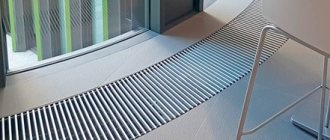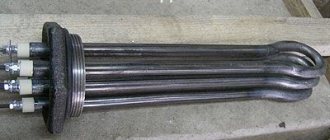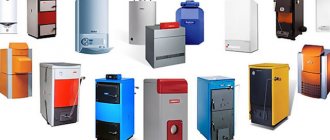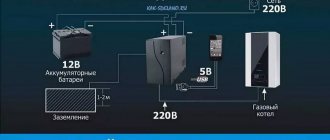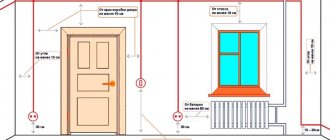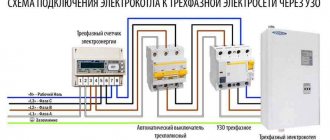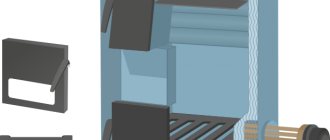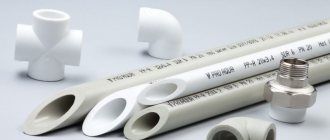Many modern heating systems are controlled by automatics and need a constant supply of electricity for correct operation. If there are regular interruptions to the energy resource, experts recommend buying a backup generator. When the lack of electricity is rare and does not last long, it is enough to install a progressive inverter for the heating boiler.
It converts the direct current coming from the battery into alternating current and allows the heating equipment to function fully for a certain period of time even in the absence of electricity. Let's take a closer look at the main characteristics of the device.
General device characteristics
An inverter is primarily a DC-to-AC converter. In parallel, it changes the transmission amplitude and generates an output signal of a suitable frequency. The device cannot charge the battery and control its current capacity by itself.
Many modern manufacturers equip their products with related elements, additional chargers and a control unit. Such models are already classified as uninterruptible power supplies (UPS) and have the ability to solve a wider range of tasks.
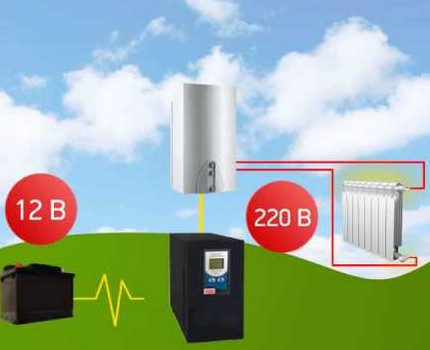
Manufacturers give a large guarantee for the uninterrupted operation of inverter equipment for boilers - from 10 to 12 years at 600-620 active cycles and battery discharge at the level of 80-83%
Integrated into the heating system, they monitor the presence of current in the network and, in the event of a sudden emergency power outage, for some time support the full operation of the equipment.
In this way, preventing the potentially possible freezing of water in pipes and radiators (in the winter season), breakdown of individual parts of the system and other unpleasant problems.
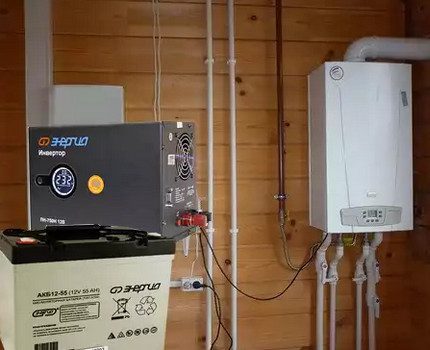

An inverter equipped with an additional battery allows heating equipment to work for a long time and efficiently even in the absence of a centralized electricity supply
Simple, low-cost products perform only one direct function - providing the boiler with energy to operate for a certain amount of time. Complex progressive modules have extended potential.
In addition to their main mission, they act as stabilizers and equalize the voltage in the system, thus protecting the equipment from unnecessary load and failure.
What is an inverter
An inverter is a device that converts direct electric current into alternating current or increases the value of voltage, frequency of alternating current. The need for such a transformation arises when creating devices and mechanisms with a sensitive system of settings that respond to the slightest change in the parameters of the environment. Inverters are used in many areas: electric welding (in fact, a welding machine is a kind of inverter), control of electric motors and electric drives, production of air conditioners and heaters, etc.
As an integral part of the device, inverters look different and may not have an individual case.


Complete set of inverter energy sources
In the modern market of household related equipment, inverters are presented in several versions. Some brands produce the most simple units that work only as voltage converters.
The rechargeable battery is not initially included in the set of such modules, but its connection by design is allowed, and the user can purchase this element separately in the future.
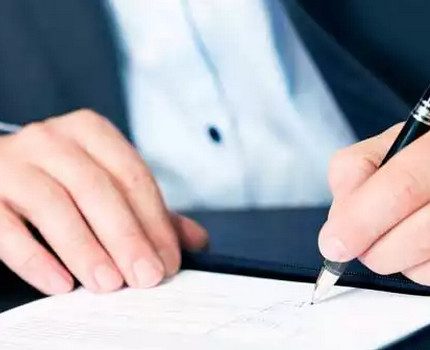

It is necessary to purchase inverter equipment only in the regional official representative of the manufacturer. There, in addition to the product, the buyer will be issued a warranty card for service and, in the event of malfunctions identified in the first working days, they will replace the product with a serviceable one.
Some types of inverters have a built-in battery of a certain, as a rule, small capacity, however, it is not possible to increase its volume due to external additional batteries.
Devices of this type maintain the operation of heating equipment for a short time and for the most part serve so that the owner can correctly disconnect the system from the power supply in an emergency.
A basic battery is built into universal units. The expansion of the device's capacity is carried out by adding external batteries. In this way, the operating time of the device is increased from several hours to several days.
Product design features
The inverter has optimal dimensions and resembles a parallelepiped in shape. Placed on the floor in the immediate vicinity of the boiler or mounted on the wall (if provided for by the design features of the purchased model).
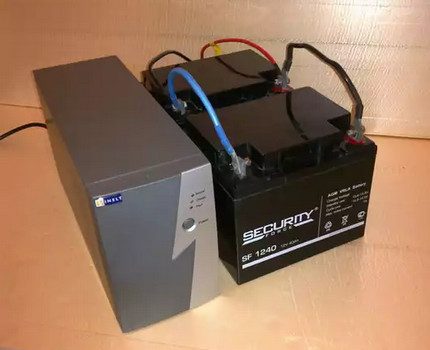

The working battery transmits direct current 12 V. The inverter absorbs it and converts it into alternating current with a traditional voltage of 220 volts, and also monitors the state of charge of the battery itself
In advanced models, a control unit with a boiler switching system and a basic storage battery are located inside the body. The first node controls the availability of energy and timely switches the equipment to an autonomous mode of operation if there are interruptions in the supply of the resource in the central network.
The second unit (battery) provides power to all electronic elements of the boiler for the entire period of power outage or until the end of the charge.
How are devices classified?
Almost all inverter devices are integral elements of a UPS (uninterruptible power supply) and perform the same function - converting DC current from the battery into AC.
In the event of an unexpected power outage, the backup power supply system is activated, and the heating equipment instantly switches to autonomous mode. This allows you to maintain the full functioning of the heating for a certain period of time - from several hours to several days.
According to the principle of operation, the devices are divided into three types:
- Off-line (backup);
- Line-interactive (line-interactive);
- On-line (double conversion).
Each type of device has its own specific characteristics and capabilities that allow solving diverse tasks. After a thorough study of the parameters of all three devices, choosing the best option for yourself will not be difficult.
Operating principle of off-line units
The off-line model has a simple design and is considered a backup. When the power grid operates in standard mode and demonstrates stability, and the voltage does not "jump" between extreme values, the device "sleeps" and does not participate in the operation of the household heating system.
If the current level drops to 175 V, the unit switches the heating boiler to battery feed. As soon as the situation recovers, the inverter UPS reconnects the heating equipment back to the mains.
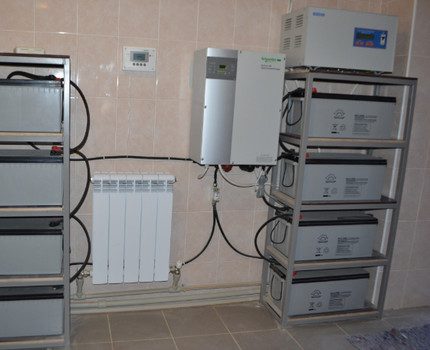

The off-line device is ideal for working in conjunction with a gas heating boiler, but only if there are no problems with voltage stabilization in the central power grid
Each transition from the main power source to the autonomous one and vice versa lasts no more than 10-15 seconds and does not in any way affect the functionality of the heating equipment.
The operating range of most off-line converters is in the range of 170-270 V.
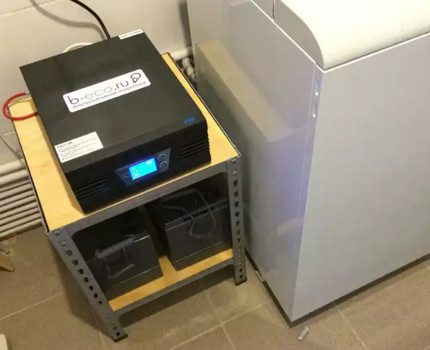

Advanced inverter converters are usually equipped with informational liquid crystal displays and current regulators. They do not have an active cooling system. Due to this, the work process is absolutely silent and does not interfere with the tenants with annoying sounds.
With a constantly "jumping" voltage, switching from the main system to the autonomous system occurs too often and leads to a rapid deterioration of the batteries and the device itself. Stabilizers are not included in the set of the device, therefore, when connected, both at the input and at the output, the mains voltage does not change.
Therefore, we recommend reading our article on how to choose a voltage stabilizer for a heating boiler. Read on for more details.
Depending on the manufacturer and model, the back-up devices can effectively operate with electrical equipment from 300 to 3,500 watts. Some products provide for cyclical operation and the ability to prevent the communication fragments of the heating system from freezing during the day or more.
How do Line-interactive modules behave?
Line-interactive (Line-interactive) device is a switching type device and is considered the best option for universal equipment. Structurally, the product consists of an off-line source, a converter, a switching relay and a low-frequency stabilizing device.
In the standard operating mode of the unit, heating equipment consumes the resource of the central energy main. The output voltage is controlled by a stabilizer and special filters (for some models), which smooth out the arising noise and neutralize the interference of the network to which the boiler itself is connected.
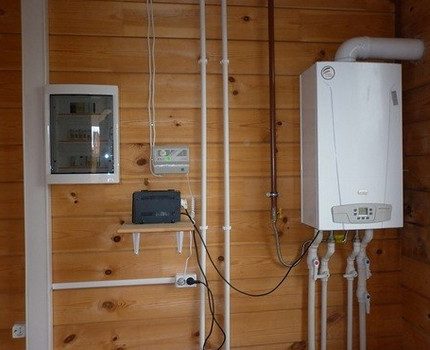

A gas boiler connected to a line-interactive converter equipped with an additional external battery can operate from 8 to 10 hours (depending on the battery capacity)
Line-interactive units supply useful energy to electrical appliances for a very short period of time (no more than 20 minutes).
To provide heating boilers with a resource, they use not ordinary linear devices, but improved products with an expansion function, providing for the connection of an additional external storage battery. Such devices can keep the boiler running for a longer time (up to 10 hours, depending on the manufacturer).
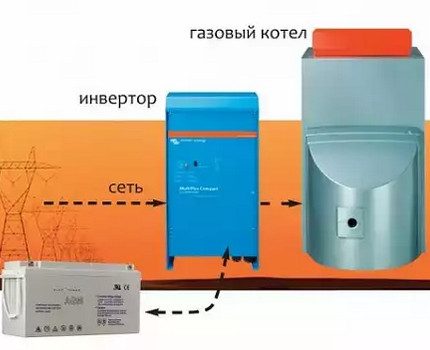

The line-interactive converter puts the battery into operation extremely quickly (approximately 2-4 seconds). The output stream of the device can be pulsed or sinusoidal. Experts recommend installing the second option on heating boilers.
The built-in current stabilizer allows the equipment to work correctly without switching to a battery with an extended voltage range. The device provides backup power from the battery and equalizes the mains voltage. The disadvantages of products include the impossibility of correcting the flow frequency of the current and the minimum smoothing of the sinusoid (no more than 20%).
Features of on-line devices
Online devices operate continuously.
The conventional wiring diagram for heating equipment in this version is built in the following sequence:
- central electrical network;
- inverter uninterruptible power supply;
- boiler.
The principle of operation of the device is reduced to re-transformation of the general parameters of the electrical network. At the first stage, when entering the inverter, the alternating voltage is converted into a stable equivalent with an indicator of 12 V.
Then the reverse maneuver takes place and at the output of the inverter apparatus, the voltage turns into an alternating voltage with a value of 220 V.
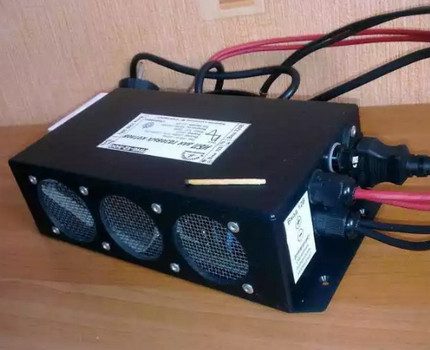

In online systems, the battery acts as a buffer and is constantly recharged. In parallel, the output converter is activated inside the battery and forms a variable from the constant voltage with indicators of 220 V 50 Hz, no longer dependent on the voltage generated at the input
The main advantage of a system of such a plan is to provide the power supply unit of the heating boiler with high-quality voltage. Among the minuses, there are only two positions: the high cost of conversion equipment and the low level of productivity.
Reserve (off-line)
This type of equipment is the simplest and is suitable for a gas heat generator in the event that there are no problems with voltage stabilization in the power grid.
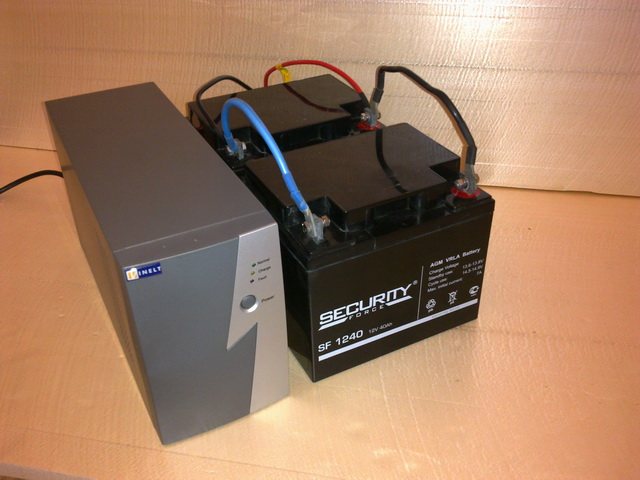

Such devices are not equipped with stabilizers, so when they are connected, the mains voltage at the input and output will remain unchanged.
Where are installed
They are suitable for those cases when the house or apartment is already equipped with a common stabilizer.
In the event that the voltage at the input of this type of UPS exceeds the operating range mark (175 - 252 Volts), the UPS stops operating from the mains and switches to battery power.
Features of the device
Depending on the model and manufacturer, samples of backup equipment can function in conjunction with electrical appliances with a capacity of 300 - 3500 watts. There are options that work perfectly in cyclical mode and prevent the heating system from freezing for more than 24 hours.


Often, manufacturers supply such equipment with information displays and a current adjustment device. Modern samples are distinguished by a silent operation mode due to the lack of active cooling.
Advantages and disadvantages of equipment
The inverter is convenient in that it is not tied to a specific type of constant voltage source. The unit can be powered using a conventional car battery, a generator set with a simple signal rectification principle, or from UPS batteries.
If the module does not have a built-in charger, the owners will have to personally control the level of capacity and the degree of discharge of the device.
Among the main advantages of the device:
- a wide range of models and the ability to choose a product with an almost ideal output sine wave;
- correct operation with all sources of rated voltage and direct current;
- reasonable cost in comparison with other similar units of similar power;
- no restrictions on increasing battery capacity and the duration of autonomous operation.
Disadvantages include criteria such as:
- lack of control over the level of charging / discharging of the battery;
- setting the response threshold is not subject to additional correction;
- the need to equip an external communication circuit for automatic activation in case of a power outage in a residential area;
- high cost of "fancy" modules with a wide range of possibilities.
The final choice of a suitable device is strictly individual. It all depends on how much the voltage "jumps" in the network, how often consumers are disconnected from the supply of the resource by the central electrical system and how long you have to sit without light.
Which is better - UPS or inverter
There are simply no fundamental differences or a set of characteristics that would differ greatly in this comparison.Among inverters and full-fledged UPSs, there are models with the required power and capacity.
Energy PN-500
The UPS is a turnkey solution capable of maintaining power to the boiler while the main power is not available. Batteries, their capacity, calibration, control and switching scheme have already been agreed, which is clearly an advantage. However, the batteries have their own resource and after several years of operation they need to be changed. Getting power supplies of the same capacity and architecture can be a problem, especially in the outback.
The inverter is not tied to a specific type of constant voltage source, so it can be powered from a car battery, from a generator with a simple rectification circuit, or from the same batteries as the UPS. However, if the inverter does not have a built-in charger, then the condition of the batteries will have to be monitored independently.
Among the advantages of the inverter:
- It is easier to find a device with an almost perfect sine wave at the output;
- Works with any DC power source and rated voltage;
- Will cost less than a UPS of the same capacity;
- Almost unlimited ability to grow source capacity and battery life.
Among the disadvantages:
- No battery charge control;
- There is no possibility to adjust the response thresholds, operating conditions;
- More often, an external switching circuit is required, for automatic switching on in the absence of electricity in the house;
- Devices with a built-in charger, control controller, switching circuit will cost about the same as a similar UPS.
The final choice should be made strictly on an individual basis. If you want to think less about equipment and enjoy more comfort, and the budget does not limit, then it is preferable to take a UPS. The same choice is reasonable if the electricity is not turned off for more than half an hour or an hour.
The inverter is good because you can use any type of batteries, and the ability to increase capacity, and therefore the duration of autonomous operation. Indispensable in cases where you have to expect long outages, up to several days. It is enough to stock up on the required number of batteries and, as they are used up, change them by connecting to an inverter. As soon as the electricity supply is restored, they can be charged again and for future use.
Basic rules for choosing a module
When planning the purchase of an inverter for a boiler, you need to pay close attention to such parameters as:
- input voltage and current indicator;
- output voltage level;
- the degree of distortion of the output voltage sinusoid;
- actual conversion factor;
- total output power.
For household gas boilers, mainly inverter installations 12-220 are used. These units convert the 12 V DC battery voltage into a 220 V sinusoidal voltage with minimal distortion.
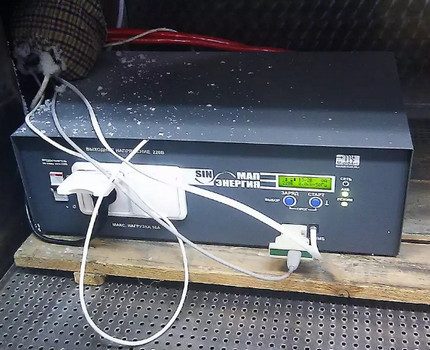

The sine wave of the inverter output voltage should not exceed 3%. These indicators mean that the waveform is as close to sinus as possible with minor deviations towards a sharp drop or cut peaks.
It is possible to acquire a more powerful bundle of units (24-220 converter and 24 V battery), but at the same time it is necessary to find out exactly what maximum input current the inverter is designed for.
Only after receiving this information should you start buying.


Inverters offered in the domestic market are originally designed for the low quality of electrical networks. The units have all the surge protection features and the option to allow the user to set upper and lower voltage limits down to volts
The controller and control unit of popular gas boilers usually consume about 150-200 watts of power.Responsible for the correct circulation of the heating fluid in the system, the circulation pump takes another 125-150 watts. To determine the indicator of the required power of the inverter, these data must be added and multiplied by 2.5 to take into account the amount of starting current at the time of starting.
The finished figures must be multiplied by 1.2 again to take into account some power reserve. Memorize or write down the received data. When buying an inverter, make sure that the base power declared by the manufacturer will certainly exceed the calculated values.
List of popular models and manufacturers
Many domestic and foreign companies, firms and organizations operate in the electrical engineering market segment. Some of them are licensed, others develop their own technologies and offer customers unique, progressive and competitive products at a very reasonable price.
Device
Inverter Energiya PN-500 is an inexpensive practical device that provides uninterrupted power supply for modern low-power boilers. Manufactured at the production facilities of ETC Energia - one of the leaders in the domestic electrical market.
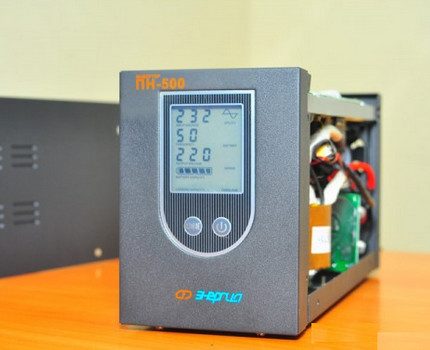

ETC Energia inverters fully comply with all GOSTs and requirements for household electrical equipment. Environmental safety and quality of products are confirmed by international certification certificates issued by the company
Connecting one basic storage battery to the device provides full autonomous operation of the fuel boiler for 6-7 hours. If you connect a second battery, the operating time will double.
The unit produces a pure sine at the output, which contributes to the preservation of the expensive electronic "filling" of modern heating boilers. When the operation of the central electrical system is normalized, the inverter automatically switches to voltage stabilization mode and protects the boiler from sudden power surges.
Device "Elim-Ukraine"
has been in the electrical equipment market for over 10 years and is highly respected by customers.
Devices manufactured under this trademark have a switching power supply, LED indication, pleasant to the eye, and demonstrate an extremely high level of efficiency (up to 98%). Produce a pure sine wave signal without distortion or overvoltage peaks.
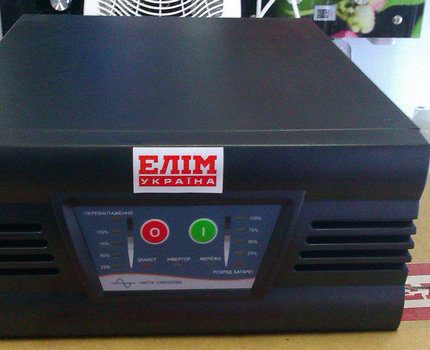

Inverters are also convenient because they work correctly with both gel and car batteries.
Equipped with protection against overheating, general overload and deep discharge of the battery. One of the expansion options allows you to connect an additional battery of any capacity to the equipment to maintain the autonomous operation of the heating system even in the absence of voltage in the central trunk networks for a day or more.
Rucelf UPI-400-12-EL unit
Rucelf UPI-400-12-EL device belongs to the category of line-interactive energy sources. It has a built-in stabilizer, which evens out the current flow in the presence of even a minimum mains voltage without using the battery. This makes it possible to economically use up the battery life without overloading and prolonging their service life.
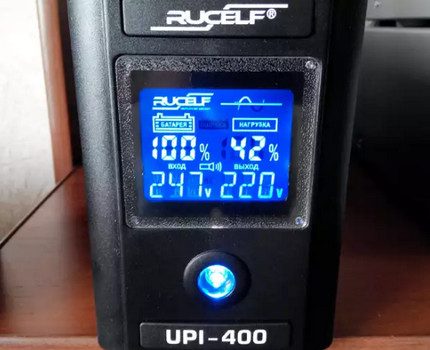

Important advantages of Rucelf UPI are completely silent operation and effective supply of devices with the necessary power supply during an emergency power outage.
Reasonable cost is another characteristic feature of the products of the Russian company Rucelf.
Thanks to this, customers can create a full-fledged autonomous infrastructure to feed heating systems during an emergency power outage or power surges.
Rules for installing a UPS for a gas boiler
Do not place the UPS close to the cold water pipes of double-circuit boilers (condensation forms on them), as well as near the heating pipes, so as not to disrupt the cooling efficiency of the inverter.Also, batteries should not be exposed to cold or excessively high temperatures.
Do not use the UPS in conjunction with lead-acid batteries, unless explicitly stated in the operating instructions for this UPS. Difference in charge current characteristics between lead acid and gel batteries
may cause malfunction UPS charger.
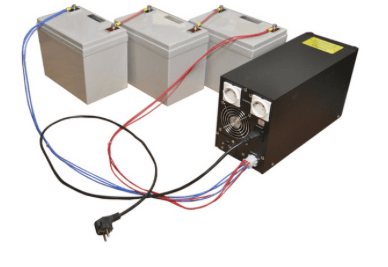

It is desirable to use offline devices in conjunction with a voltage stabilizer connected between them and an external network.
When a phase-dependent gas boiler is used in the heating system together with a UPS, its output is connected to the load through an isolation transformer. This is due to the fact that when the inverter is operating, both of its outputs are phases relative to ground, while a phase-dependent boiler requires a well-defined phase and neutral of the supply. For this, an isolation transformer is used, one of the terminals of the secondary winding of which is grounded.

